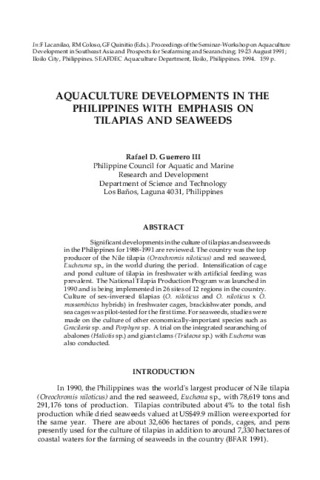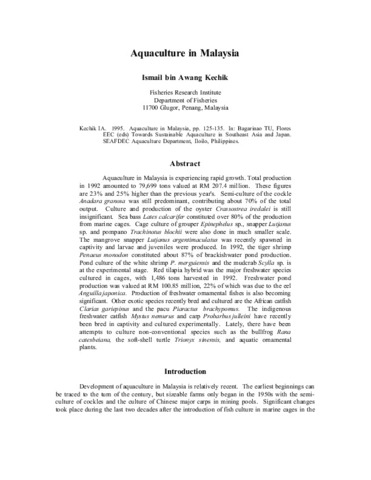Aquaculture developments in the Philippines with emphasis on tilapias and seaweeds
- Global styles
- MLA
- Vancouver
- Elsevier - Harvard
- APA
- Help

Date
1994Author
Page views
6,257ASFA keyword
AGROVOC keyword
Taxonomic term
Metadata
Show full item recordShare
Abstract
Significant developments in the culture of tilapias and seaweeds in the Philippines for 1988-1991 are reviewed. The country was the top producer of the Nile tilapia (Oreochromis niloticus) and red seaweed, Eucheuma sp., in the world during the period. Intensification of cage and pond culture of tilapia in freshwater with artificial feeding was prevalent. The National Tilapia Production Program was launched in 1990 and is being implemented in 26 sites of 12 regions in the country. Culture of sex-inversed tilapias (O. niloticus and O. niloticus x O. mossambicus hybrids) in freshwater cages, brackishwater ponds, and sea cages was pilot-tested for the first time. For seaweeds, studies were made on the culture of other economically-important species such as Gracilaria sp. and Porphyra sp. A trial on the integrated searanching of abalones (Haliotis sp.) and giant clams (Tridacna sp.) with Euchema was also conducted.
Suggested Citation
Guerrero, R. D. III (1994). Aquaculture developments in the Philippines with emphasis on tilapias and seaweeds. In F. Lacanilao, R. M. Coloso, & G. F. Quinitio (Eds.), Proceedings of the Seminar-Workshop on Aquaculture Development in Southeast Asia and Prospects for Seafarming and Searanching; 19-23 August 1991; Iloilo City, Philippines. (pp. 75-78). Tigbauan, Iloilo, Philippines: Aquaculture Department, Southeast Asian Fisheries Development Center.
Type
Conference paperISBN
971851127XCollections
- ADSEA '91 [21]
Related items
Showing items related by title, author, creator and subject.
-
Aquaculture in Malaysia
Kechik, Ismail bin Awang. (Aquaculture Department, Southeast Asian Fisheries Development Center, 1995)Aquaculture in Malaysia is experiencing rapid growth. Total production in 1992 amounted to 79,699 tons valued at RM 207.4 million. These figures are 23% and 25% higher than the previous year's. Semi-culture of the cockle ... -
Aquaculture development in Thailand
Sirikul, Boonsong; Luanprida, Somsak; Chaiyakam, Kanit; Sriprasert, Revadee (Aquaculture Department, Southeast Asian Fisheries Development Center, 1988)Aquaculture practised in Thailand is in the form of pond culture and cage culture in freshwater, brackishwater and coastal areas. The main species cultured include freshwater prawns, brackishwater shrimp, cockles, mussels, ... -
The Philippine aquaculture industry
Camacho, Arsenio S.; Macalincag-Lagua, Natividad (Aquaculture Department, Southeast Asian Fisheries Development Center, 1988)The aquaculture sector of the Philippine fishing industry registered the highest growth rate of 12.5% in 1977-1986. The contribution of aquaculture to the total fish production was equivalent to 24% in 1986 compared to ...






